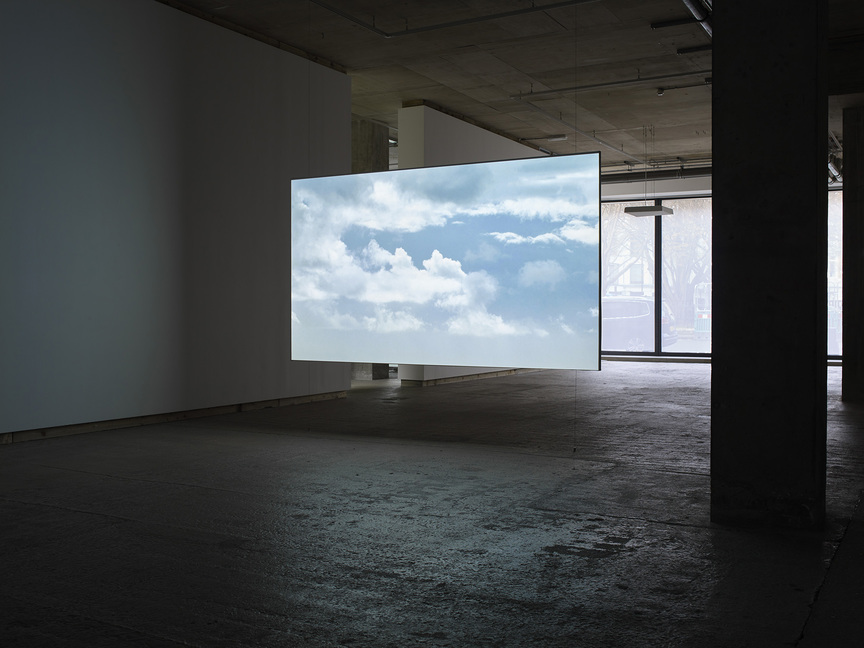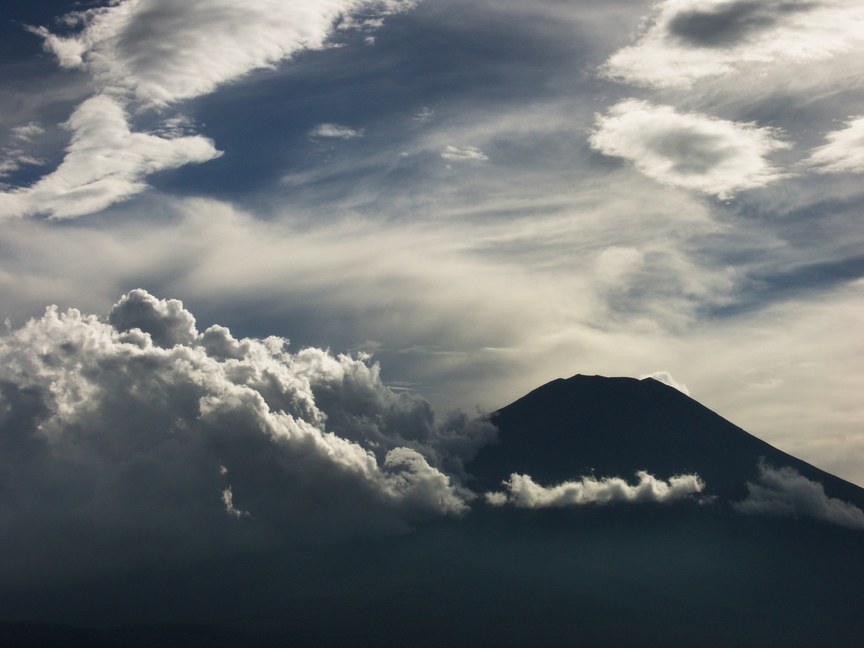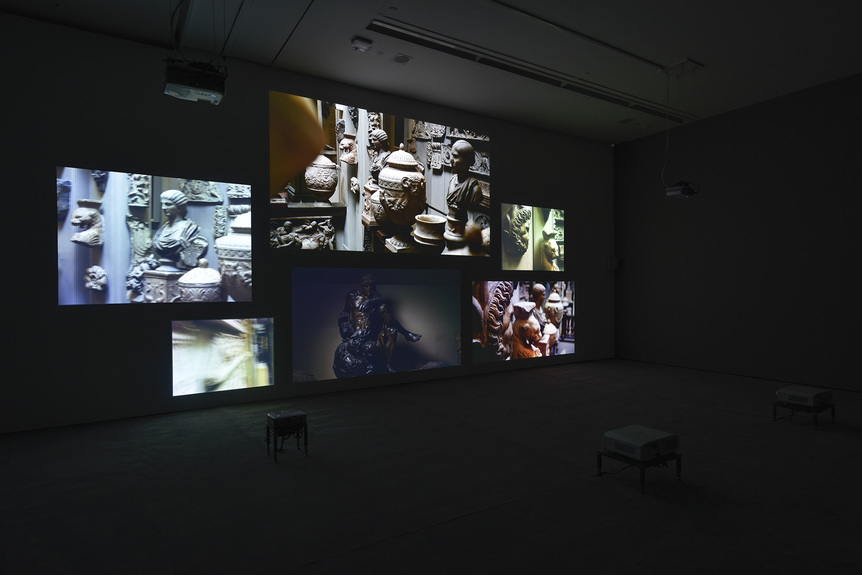
R
E
V N
E
X
T
Born in Indonesia to an Indonesian-Chinese father and Australian mother, Fiona Tan relocated to Amsterdam in 1984, where she has been based since. Preoccupied with the nature of images, Tan’s works investigate issues of representation and highlight liminal spaces—between photographs, films and installations, as well as fact and fiction. Informed by her 2018 fellowship as artist-in-residence at the Getty Center in Los Angeles, Tan’s solo exhibition “Elsewhere,” comprising video installations inspired by utopian texts, opened in November, 2018, at London’s Frith Street Gallery, and will be followed by a major solo exhibition at Brussels’s Musée des Arts Contemporains (MAC) in April. ArtAsiaPacific sat down with the artist to discuss her recent projects, her plans for her upcoming show, and the topics of concern that have persisted throughout her practice.
The focal point of your exhibition “Elsewhere” at Frith Street Gallery is your new film, which lends its name to the show. Could you tell me about Elsewhere (2018)?
Elsewhere came out of several things; it has to do with historical research I am engaged with in Belgium for my forthcoming show at the MAC’s Grand Hornu, “L’archive des ombres” (“Shadow Archive”). In my research process I found myself thinking about utopic city planning and architectural models. There have been several classical texts over the centuries exploring utopias, and I’ve been studying them. The contrasts between pre- and post-20th century discussions of the ideal world, such as News From Nowhere (1890) by William Morris, City of the Sun (1602) by Tommaso Campanella, and the contemporary writings of Anna L. Tsing, and Norman M. Klein’s The History of Forgetting (1997), are striking.
It is obvious that we can easily imagine dystopias but a utopian world is foreign to our current frame of mind and I wanted to wrap my head around that. I also kept revisiting a great film by Chantal Akerman called News From Home (1977). This film consists of footage that Akerman shot of New York while she was living there in the 1970s. The voice-over, on the other hand, is of Akerman reading letters written by her mother, at home in Belgium. It’s brilliant. As a viewer, you end up making sense of the discrepancy somehow, so the film creates itself inside your mind. I ended up trying to write my own description of utopia based on my feelings of dislocation to accompany scenes that I had shot in Los Angeles. The voiced narration and moving images comprise the video installation.
In contrast to your previous work, however, it is not you voicing the script in Elsewhere. What was the reason for this?
I do regularly use my own voice but for this piece I did not want the first person—the “I”—to be me. I wanted the protagonist to be a fictional character, removed from me personally, and I thought an American voice would be fitting for the very American landscape that you see on screen.
Your interest in landscape is also evident in your feature-length film Ascent (2016), which is set around Mount Fuji and tells the story of two lovers through found images and voiced narration. What is it about working with landscapes that interests you?
You can project almost anything on a landscape. It’s a surface where you can play things out—an imaginary space occupying several moments and ideas at the same time. Sometimes, the images in Ascent match the text and at others they diverge. Scale is also important—the scale of the projection in relation to your body.
In both Elsewhere and Ascent you blur stills into moving image and converge fact and fiction. What is the process of building these narratives?
Researching for these works is very intense and it seems to be getting more so as time goes on, but it’s quite idiosyncratic as well. I’m not a trained historian or academic so these investigations are undertaken in my own erratic way. I am attempting to become more thorough as I get older, perhaps because I realize more and more the scale of what I don’t know.
Do you see change as a challenge? For example, with digital photography becoming ubiquitous, has your work been affected by the associated technological and social innovations?
That’s a big question. I think artists are often in a double bind because we are dependent upon our chosen media. I use film, video and photography, and the capabilities and characteristics of these media are dictated by large multinational companies. That’s both an opportunity and a limitation. Just as painting morphed with the introduction of oil on canvas, more recent art changed when the first handheld video cameras came onto the market. This technical development was happening while performance art was emerging, so artists started recording their performances because they could. And that had considerable influence on early video art. All these factors coalesced. Mind you, it’s always been like that.
In short, yes, technical advances influence my work. Sometimes I react very consciously, at other times I’ve responded without realizing it, and on other occasions I don’t have a choice.
Has your practice changed in the run up to your forthcoming exhibition at MAC—the manifestation of a two-year research period?
I often think that the most simple questions are the most difficult ones to answer. Earlier in my career I was asking myself: What is a picture, what’s an image? Now I’m asking: What is a collection? Why collect? What should be collected?
Just before this two-year research project, I was looking into early 20th-century collections and musea, resulting in the installations Inventory (2012) and Depot (2015). For the show at MAC, there is one particular archive that I have been delving into called the Mundaneum, sometimes described as a “Paper Google.” The Mundaneum stems from Paul Otlet’s endeavor to catalog all human knowledge. He received funding from the Belgian King for this ultimate archival project. Working about 100 years ago, computers didn’t yet exist, so he was writing on index cards and filing these in drawers and cabinets. By circa 1930 he had over 16 million index cards. The Mundaneum still has a few million of these, but over time much of the archive has become lost or damaged. And of course Otlet wasn’t finished.
Could he ever have finished it? It sounds like an impossible enterprise!
It is but he didn’t realize that; he had a mindset from the 19th century and a positivist idea of what knowledge is. I’ve been looking into his work—quite eccentric but in a sane and serious way, and his plans got bigger and bigger. His aim was not only to amass this amazing bibliography and archive, but to ensure that it was freely accessible to the entire world. He believed that once he had achieved this goal, the end-result would be world peace.
He was involved in many international associations and had a World Museum in the center of Brussels, conceived along similar lines. He also wanted to build a World City in which he could house his World Archive, so he worked together with several architects including Le Corbusier on city plans. He dedicated his whole life to this vision. I will be exhibiting some of his drawings and maps because to me he is an obsessed, autodidactic artist; a very bad draughtsman but a dreamer of delightful schemes.
Is anthropology relevant to your works?
Yes, always. But I also wonder constantly, what is anthropology? How do anthropology and contemporary art relate to each other? What role do images play? In a way, that is my practice in a nutshell—I am always circling around these questions.
My work develops organically—I think of it as a spiral or a cloud. I’m not always pushing the same buttons but there are fascinations that I repeatedly come back to. These also include issues like movement and stillness, working with photography to create moving image and vice versa, all of which are going on in Elsewhere.
Adding to the moving image of your video installation Vertical Red (2018), which depicts the endless stream of Los Angeles traffic, is the directional sound you use. Could you tell me how and why the sound was orchestrated?
The three vertical filmworks, Vertical Red, Vertical White and Vertical Wide (all 2018) at “Elsewhere” are minimal and, for me, are almost like painting—moving paintings. They don’t have a beginning or an end, they just keep on going. When you’ve been living in Los Angeles for a year, traffic becomes a major preoccupation.
Only Vertical Red has sound. The sound is triggered every time you see a red brake light. It’s not mathematical or mechanical—I wanted it to be playful, and musical but not quite music. The sound is both synchronized and at odds with the image. I want it to be hovering between an orchestrated reality and an organized virtual reality.
Can we expect you to be doing more sound work in the future or are there other new avenues you are exploring?
I am currently producing a CGI video piece. This is the first time that I am working in this way; the method is in many ways diametrically opposed to physically filming and shooting. I find this very interesting and challenging—I am slowly but surely working towards pinpointing what constitutes the digital as opposed to the analog. Where are we now with these kinds of images? And where are we headed? I am also working on a piece that I shot at the same location on digital film and 16mm analog at the same time. I’ve done similar things before, but this time I will not be transferring the film onto video, I want to confront the two media and see what happens.
Fiona Tan’s Ascent will be screened at London’s Whitechapel Gallery on January 10, 2019.
Her solo exhibition, “Elsewhere,” is on view at Frith Street Gallery, London, until January 19, 2019.
“Shadow Archive” will be held at the Musee d’Art Contemporain Grand Hornu, Brussels, from April 7 to September 1, 2019.
To read more of ArtAsiaPacific’s articles, visit our Digital Library.















